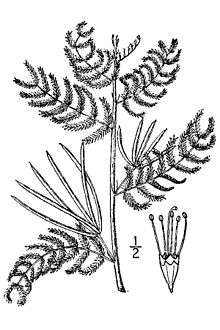Desmanthus leptolobus
| Desmanthus leptolobus | |
|---|---|
 | |
| Scientific classification | |
| Kingdom: | Plantae |
| Clade: | Angiosperms |
| Clade: | Eudicots |
| Clade: | Rosids |
| Order: | Fabales |
| Family: | Fabaceae |
| Genus: | Desmanthus |
| Species: | D. leptolobus |
| Binomial name | |
| Desmanthus leptolobus | |
Desmanthus leptolobus, known as prairie mimosa, prairie bundleflower or slenderlobe bundleflower,[2] is a flowering plant of the genus Desmanthus. It is native to Kansas, Oklahoma, and Texas and has spread Missouri and New Mexico.[3] It is often locally abundant over large expanses of rolling prairie.[4]
Uses
Root bark of D. leptolobus has been found to contain a psychedelic compound called N,N-DMT and other related tryptamines. While its only reported quantitative analysis found concentrations of 0.14% of N,N-DMT (lower than has been found in Desmanthus illinoensis), one person documented a "subjectively stronger response" than D. illinoensis.[5][6] Desmanthus species have been found to have variable concentrations of N,N-DMT.[5]
References
- ↑ "Desmanthus leptolobus". ipni.org. International Plant Names Index. Retrieved 2018-09-23.
- ↑ Desmanthus leptolobus, USDA Natural Resources Conservation Service PLANTS Profile, 2018-09-23
- ↑ "Biota of North America Project - Desmanthus leptolobus 2014 County Map". bonap.net. Biota of North America Project. Retrieved 2018-09-23.
- ↑ "Desmanthus leptolobus". www.troutsnotes.com. Retrieved 2008-04-27.
- 1 2 "Erowid Online Books : "Ayahuasca: alkaloids, plants, and analogs" by Keeper of the Trout". www.erowid.org. Retrieved 2008-04-27.
- ↑ DeKorne, Jim; Aardvark, David; Trout, K. "Ayahuasca Analogues and Plant-based Tryptamines: the Best of the Entheogen Review 1992-1999, Second Edition" (PDF). Retrieved 2018-09-23.
External links
- Erowid Desmanthus Vault
- Desmanthus leptolobus TORREY & A.GRAY
- Ayahuasca: alkaloids, plants & analogs: assembled by Keeper of the Trout
This article is issued from
Wikipedia.
The text is licensed under Creative Commons - Attribution - Sharealike.
Additional terms may apply for the media files.